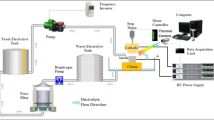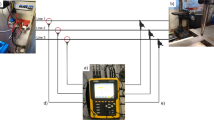Abstract
Electron beam melting (EBM) is one of the growing processes of additive manufacturing technology (AMT) to fabricate 3D parts from various difficult-to-process materials such as titanium alloys. A major limitation of the EBM process is the poor surface finish of the produced parts which ultimately demands a subsequent subtractive method (secondary finishing operation) to improve the surface finish for shaping the part to be fit for-end use applications where high surface finish is commonly required. With respect to the EBM layer build direction, the fabricated part has different orientations with varying surface characteristics. Therefore, in order to perform secondary finishing operation (e.g., milling) there are different choices of EBM part orientation to select the direction of tool feed. In this research, 3D parts of titanium alloy (gamma titanium aluminide; γ-TiAl) are additively manufactured through EBM process. The effect of EBM layer/part orientation on the milling performance is further investigated in terms of surface finish improvement and edge chipping evaluation. It has been observed that the EBM layer/part orientation with respect to milling tool feed direction (TFD) plays a vital role in milling performance. Thus, a care must be taken to select the appropriate tool feed direction and layer/part orientation in order to achieve maximum surface finish with minimum edge chipping. The results revealed the vertical milling can be adopted as a secondary finishing operation to be performed on EBM produced parts of γ-TiAl and it allows to significantly improve the poor surface finish generated by EBM (Ra 31 μm). Furthermore, among the available part orientation choices, the part orientation in which the milling tool is fed across the EBM layer build direction is the best orientation resulting into high surface finish (Ra 0.12 μm) with relatively smooth edges (minimum chipping-off).
Similar content being viewed by others
References
Hu D (Dec. 2001) Effect of composition on grain refinement in TiAl-based alloys. Intermetallics 9(12):1037–1043
Wu X (Oct. 2006) Review of alloy and process development of TiAl alloys. Intermetallics 14(10):1114–1122
Biamino S, Penna A, Ackelid U, Sabbadini S, Tassa O, Fino P, Pavese M, Gennaro P, Badini C (Jun. 2011) Electron beam melting of Ti–48Al–2Cr–2Nb alloy: microstructure and mechanical properties investigation. Intermetallics 19(6):776–781
Klocke F, Lung D, Arft M, Priarone PC, Settineri L (2013) On high-speed turning of a third-generation gamma titanium aluminide. Int J Adv Manuf Technol 65:155–163
Harrysson OLA, Cansizoglu O, Marcellin-Little DJ, Cormier DR, West HA (2008) Direct metal fabrication of titanium implants with tailored materials and mechanical properties using electron beam melting technology. Mater Sci Eng C 28(3):366–373
Priarone PC, Rizzuti S, Ruffa S, Settineri L (2013) Drilling experiments on a gamma titanium aluminide obtained via electron beam melting. Int J Adv Manuf Technol 69(1–4):483–490
Hernandez J, Murr LE, Gaytan SM, Martinez E, Medina F, Wicker RB (2012) Microstructures for two-phase gamma titanium Aluminide fabricated by electron beam melting. Metallogr Microstruct Anal 1(1):14–27
Kumar J, Khamba JS (2008) An experimental study on ultrasonic machining of pure titanium using designed experiments. J Brazilian Soc Mech Sci Eng 30(3):231–238
Todai M, Nakano T, Liu T, Yasuda HY, Hagihara K, Cho K, Ueda M, Takeyama M (2017) Effect of building direction on the microstructure and tensile properties of Ti-48Al-2Cr-2Nb alloy additively manufactured by electron beam melting. Addit Manuf 13:61–70
Safdar A, He HZ, Wei L, Snis A, Chavez de Paz LE (2012) Effect of process parameters settings and thickness on surface roughness of EBM produced Ti-6Al-4V. Rapid Prototyp J 18(5):401–408
Koike M, Martinez K, Guo L, Chahine G, Kovacevic R, Okabe T (2011) Evaluation of titanium alloy fabricated using electron beam melting system for dental applications. J Mater Process Technol 211(8):1400–1408
Pandey PM, Venkata Reddy N, Dhande SG (2003) Improvement of surface finish by staircase machining in fused deposition modeling. J Mater Process Technol 132(1–3):323–331
Karlsson J, Snis A, Engqvist H, Lausmaa J (2013) Characterization and comparison of materials produced by electron beam melting (EBM) of two different Ti–6Al–4V powder fractions. J Mater Process Technol 213(12):2109–2118
Galantucci LM, Lavecchia F, Percoco G (2010) Quantitative analysis of a chemical treatment to reduce roughness of parts fabricated using fused deposition modeling. CIRP Ann Manuf Technol 59(1):247–250
Braga FJC, Marques RFC, Filho E d A, Guastaldi AC (2007) Surface modification of Ti dental implants by Nd:YVO4 laser irradiation. Appl Surf Sci 253(23):9203–9208
Campanelli SL, Casalino G, Contuzzi N, Ludovico AD (2013) Taguchi optimization of the surface finish obtained by laser ablation on selective laser molten steel parts. Procedia CIRP 12:462–467
Yasa E, Kruth J-P, Deckers J (2011) Manufacturing by combining selective laser melting and selective laser erosion/laser re-melting. CIRP Ann Manuf Technol 60(1):263–266
Ramos-Grez JA, Bourell DL (2004) Reducing surface roughness of metallic freeform-fabricated parts using non-tactile finishing methods. Int J Mater Prod Technol 21(4):297–316
Lamikiz A, Sánchez JA, López de Lacalle LN, Arana JL (2007) Laser polishing of parts built up by selective laser sintering. Int J Mach Tools Manuf 47(12–13):2040–2050
Yasa E, Deckers J, Kruth J (2011) The investigation of the influence of laser re-melting on density, surface quality and microstructure of selective laser melting parts. Rapid Prototyp J 17(5):312–327
Hassanin H, Modica F, El-Sayed AM, Liu J, Essa K (2016) Manufacturing of Ti–6Al–4V micro-implantable parts using hybrid selective laser melting and micro-electrical discharge machining. Adv Eng Mater 18(9):1544–1549
Zhang B, Zhu L, Liao H, Coddet C (2012) Improvement of surface properties of SLM parts by atmospheric plasma spraying coating. Appl Surf Sci 263:777–782, 2012
Ahmed N, Darwish S, Alahmari AM (2016) Laser ablation and laser-hybrid ablation processes: a review. Mater Manuf Process 31(9):1121–1142
Ahmed N, Darwish S, Alahmari AM, Salik K (2015) Laser ablation process competency to fabricate microchannels in titanium alloy. Mater Manuf Process 30(11):1290–1297
Kumar J, Khamba JS, Mohapatra SK (2008) Investigating and modeling tool-wear rate in the ultrasonic machining of titanium. Int J Adv Manuf Technol 41(11–12):1107–1117
Ahmed N et al (2017) Electron beam melting of titanium alloy and surface finish improvement through rotary ultrasonic machining. Int J Adv Manuf Technol:1–13
Beranoagirre A, Olvera D, López de Lacalle LN (2011) Milling of gamma titanium–aluminum alloys. Int J Adv Manuf Technol 62(1–4):83–88
Sharman ARC, Aspinwall DK, Dewes RC, Bowen P (2001) Workpiece surface integrity considerations when finish turning gamma titanium aluminide. Wear 249(5–6):473–481
Priarone PC, Robiglio M, Settineri L, Tebaldo V (2014) Milling and turning of titanium aluminides by using minimum quantity lubrication. Procedia CIRP 24, no. Mic, 62–67
Priarone PC, Rizzuti S, Settineri L, Vergnano G (2012) Effects of cutting angle, edge preparation, and nano-structured coating on milling performance of a gamma titanium aluminide. J Mater Process Technol 212(12):2619–2628
Iquebal AS, El Amri S, Shrestha S, Wang Z, Manogharan GP, Bukkapatnam S (2017) Longitudinal milling and fine abrasive finishing operations to improve surface integrity of metal AM components. Procedia Manuf 10:990–996
Priarone PC, Rizzuti S, Rotella G, Settineri L (2012) Tool wear and surface quality in milling of a gamma-TiAl intermetallic. Int J Adv Manuf Technol 61(1–4):25–33
Mohammad A, Alahmari A, Mohammed M, Renganayagalu R, Moiduddin K (2017) Effect of energy input on microstructure and mechanical properties of titanium aluminide alloy fabricated by the additive manufacturing process of electron beam melting. Materials (Basel) 10(2):211
“Gamma Titanium Aluminide.” [Online]. Available: http://www.matweb.com/search/DataSheet.aspx?MatGUID=193daaf06f3f4a5692615d96bfdc1f76. Accessed 20 Jul 2017
Mitra R (2015) Structural intermetallics and intermetallic matrix composites. CRC Press
Weeks CE (2005) Evaluation of a gamma titanium aluminide for hypersonic structural applications, Thesis, Georgia Institute of Technology
Baicheng Z, Xiaohua L, Jiaming B, Junfeng G, Pan W, Chen-nan S, Muiling N, Guojun Q, Jun W (2017) Study of selective laser melting (SLM) Inconel 718 part surface improvement by electrochemical polishing. Mater Des 116:531–537, 2017
Acknowledgements
The authors extend their appreciation to the Deanship of Scientific Research at King Saud University for funding this work through research group no. RG-1438-088.
Author information
Authors and Affiliations
Corresponding author
Rights and permissions
About this article
Cite this article
Anwar, S., Ahmed, N., Abdo, B.M. et al. Electron beam melting of gamma titanium aluminide and investigating the effect of EBM layer orientation on milling performance. Int J Adv Manuf Technol 96, 3093–3107 (2018). https://doi.org/10.1007/s00170-018-1802-7
Received:
Accepted:
Published:
Issue Date:
DOI: https://doi.org/10.1007/s00170-018-1802-7




